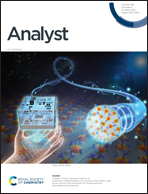Protein–protein interactions in solutions of monoclonal antibodies probed by the dependence of the high-frequency viscosity on temperature and concentration
Abstract
Using a quartz crystal microbalance with dissipation monitoring (QCM-D), the complex high-frequency viscosity, ![[small eta, Greek, tilde]](https://www.rsc.org/images/entities/i_char_e110.gif) = η′ − iη′′, of concentrated solutions of a monoclonal antibody (mAb) was studied with respect to its dependence on temperature, T, and concentration, c. Lysozyme and bovine serum albumin (BSA) served as reference materials. Viscoelasticity was found for the mAb solution, while the reference materials behaved like Newtonian liquids. The QCM-D probes the solution's dynamics on the time scale of a few tens of nanoseconds. The processes of relaxation accessed with the QCM-D are not amenable to standard viscometry. The inverse loss tangent at 15 MHz (equal to η′′/η′ at 15 MHz, quantifying the elastic contribution to the oscillatory stress) was between 0.1 and 0.5 for the concentrated mAb solutions. It decreased with increasing temperature and decreasing pH. Activation energies of viscous flow, Ea,η, were derived from the functions η′(T). Ea,η was found to be higher for the mAb solutions than for water. No such increase was found for the reference materials. This difference evidences protein–protein interactions (PPIs) between the mAb molecules, which do not exist in the same way for lysozyme and BSA. The excipients citrate and arginine did not noticeably affect the mAb's high-frequency viscosity as determined with the QCM-D.
= η′ − iη′′, of concentrated solutions of a monoclonal antibody (mAb) was studied with respect to its dependence on temperature, T, and concentration, c. Lysozyme and bovine serum albumin (BSA) served as reference materials. Viscoelasticity was found for the mAb solution, while the reference materials behaved like Newtonian liquids. The QCM-D probes the solution's dynamics on the time scale of a few tens of nanoseconds. The processes of relaxation accessed with the QCM-D are not amenable to standard viscometry. The inverse loss tangent at 15 MHz (equal to η′′/η′ at 15 MHz, quantifying the elastic contribution to the oscillatory stress) was between 0.1 and 0.5 for the concentrated mAb solutions. It decreased with increasing temperature and decreasing pH. Activation energies of viscous flow, Ea,η, were derived from the functions η′(T). Ea,η was found to be higher for the mAb solutions than for water. No such increase was found for the reference materials. This difference evidences protein–protein interactions (PPIs) between the mAb molecules, which do not exist in the same way for lysozyme and BSA. The excipients citrate and arginine did not noticeably affect the mAb's high-frequency viscosity as determined with the QCM-D.



 Please wait while we load your content...
Please wait while we load your content...